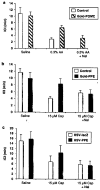Herpes simplex virus vector-mediated gene delivery for the treatment of lower urinary tract pain
- PMID: 19242523
- PMCID: PMC2732574
- DOI: 10.1038/gt.2009.19
Herpes simplex virus vector-mediated gene delivery for the treatment of lower urinary tract pain
Abstract
Interstitial cystitis (IC)/painful bladder syndrome (PBS) is a painful debilitating chronic visceral pain disorder of unknown etiology that affects an estimated 1 million people in the United States alone. It is characterized by inflammation of the bladder that results in chronic pelvic pain associated with bladder symptoms of urinary frequency and urgency. Regardless of the etiology, IC/PBS involves either increased and/or abnormal activity in afferent nociceptive sensory neurons. Pain-related symptoms in patients with IC/PBS are often very difficult to treat. Both medical and surgical therapies have had limited clinical utility in this debilitating disease and numerous drug treatments, such as heparin, dimethylsulfoxide and amitriptyline, have proven to be palliative at best, and in some IC/PBS patients provide no relief whatsoever. Although opiate narcotics have been employed to help alleviate IC/PBS pain, this strategy is fraught with problems as systemic narcotic administration causes multiple unwanted side effects including mental status change and constipation. Moreover, chronic systemic narcotic use leads to dependency and need for dose escalation due to tolerance; therefore, new therapies are desperately needed to treat refractory IC/PBS. This has led our group to develop a gene therapy strategy that could potentially alleviate chronic pelvic pain using the herpes simplex virus-directed delivery of analgesic proteins to the bladder.
Figures



Similar articles
-
Gene therapy for bladder overactivity and nociception with herpes simplex virus vectors expressing preproenkephalin.Hum Gene Ther. 2009 Jan;20(1):63-71. doi: 10.1089/hum.2008.094. Hum Gene Ther. 2009. PMID: 20377371 Free PMC article.
-
Herpes Simplex Virus Vector-Mediated Gene Delivery of Poreless TRPV1 Channels Reduces Bladder Overactivity and Nociception in Rats.Hum Gene Ther. 2015 Nov;26(11):734-42. doi: 10.1089/hum.2015.026. Epub 2015 Aug 31. Hum Gene Ther. 2015. PMID: 26204493 Free PMC article.
-
Molecular pathogenesis of interstitial cystitis/bladder pain syndrome based on gene expression.J Cell Physiol. 2019 Aug;234(8):12301-12308. doi: 10.1002/jcp.28009. Epub 2019 Jan 4. J Cell Physiol. 2019. PMID: 30609029 Review.
-
Interstitial cystitis: an unsolved enigma.Clin J Am Soc Nephrol. 2009 Nov;4(11):1844-57. doi: 10.2215/CJN.02000309. Epub 2009 Oct 1. Clin J Am Soc Nephrol. 2009. PMID: 19808225 Review.
-
The potential of non-adrenergic, non-cholinergic targets in the treatment of interstitial cystitis/painful bladder syndrome.J Physiol Pharmacol. 2012 Jun;63(3):209-16. J Physiol Pharmacol. 2012. PMID: 22791634 Review.
Cited by
-
Adenovirus-Mediated Gene Delivery: Potential Applications for Gene and Cell-Based Therapies in the New Era of Personalized Medicine.Genes Dis. 2017 Jun;4(2):43-63. doi: 10.1016/j.gendis.2017.04.001. Epub 2017 Apr 27. Genes Dis. 2017. PMID: 28944281 Free PMC article.
-
HSV Recombinant Vectors for Gene Therapy.Open Virol J. 2010 Jun 18;4:123-56. doi: 10.2174/1874357901004030123. Open Virol J. 2010. PMID: 20835362 Free PMC article.
-
Effects of herpes simplex virus vector-mediated enkephalin gene therapy on bladder overactivity and nociception.Hum Gene Ther. 2013 Feb;24(2):170-80. doi: 10.1089/hum.2011.180. Epub 2013 Feb 14. Hum Gene Ther. 2013. PMID: 23316929 Free PMC article.
-
Development of viral vectors for gene therapy for chronic pain.Pain Res Treat. 2011;2011:968218. doi: 10.1155/2011/968218. Epub 2011 Apr 7. Pain Res Treat. 2011. PMID: 22110937 Free PMC article.
-
Gene therapy as future treatment of erectile dysfunction.Expert Opin Biol Ther. 2010 Sep;10(9):1305-14. doi: 10.1517/14712598.2010.510510. Expert Opin Biol Ther. 2010. PMID: 20662742 Free PMC article. Review.
References
-
- Doggweiler-Wiygul R, Blankenship J, MacDiarmid SA. Review on chronic pelvic pain from a urological point of view. World J Urol. 2001;19:160–165. - PubMed
-
- Batra AK, Hanno PM, de Groat WC. Interstitial cystitis. In: Sant GR, editor. AUA Update Series. 2. Vol. 19. American Urological Association; 1999.
-
- Ratner V. Interstitial cystitis: a chronic inflammatory bladder condition. World J Urol. 2001;19:157–159. - PubMed
-
- Rivas DA, Chancellor MB, Blaivas JG. Interstitial cystitis. Adv Urol. 1994:229–265.
-
- Oravisto KJ. Epidemiology of interstitial cystitis. Ann Chir Gynaecol Fenn. 1975;64:75–77. - PubMed
MeSH terms
Substances
Grants and funding
LinkOut - more resources
Full Text Sources
Other Literature Sources
Medical

